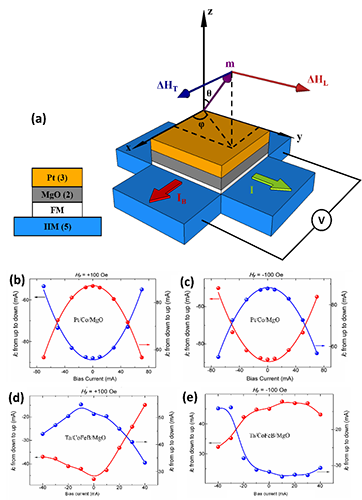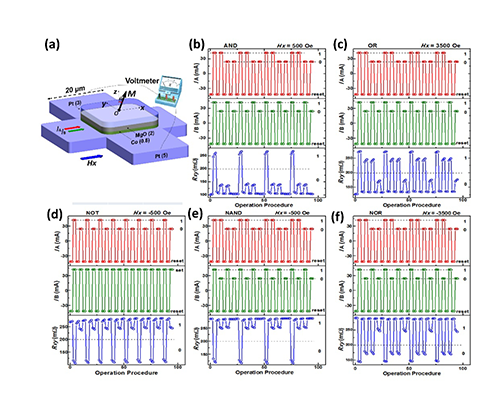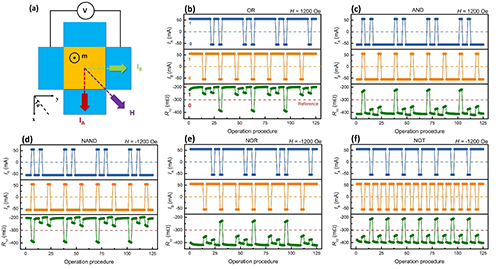A nonvolatile multifunctional reprogrammable spin logic cell
Date:20-02-2017 Print
In this era of colossal data, more than 2 quintillion bytes of data were created every day. The huge amount of data bring us not only unprecedented convenience and opportunities but also incomparably severe challenges in data processing at the same time. The processing performance of computers is known to be dominated almost entirely from the logic devices. However, the traditional strategy that aims at miniaturization of logic devices to increase the density of integration is going to encounter its ceiling due to the physical and lithographic restrictions. Communities in the field of condensed matter physics, microelectronics and material sciences are thus now urgently searching for probable alternatives. One promising candidate is the spin-based logic device.
The nonvolatile nature of magnetic system is the ideal property for the processing in memory architecture which overcomes the latency inherent of data transfer between processor and memory, known as the Von Neumann bottleneck, and will improve the efficiency of data processing. In this regard, many spin-logic solutions based on domain wall motion, spin wave propagation or magnetic semiconductor have been proposed and some of them are even experimentally demonstrated. Nevertheless, further application requires the compatibility with complementary metal oxide semiconductor (CMOS) architecture, which can be hardly satisfied by aforementioned proposals. On the other hand, besides reducing the size of logic gates, increasing the number of operation performed per logic cell is one of the most feasible way to improve the speed of computers, which is inaccessible to be realized by current silicon-based logic devices. A natural question arises: can we find such kind of logic cell that combines nonvolatility with multifunctionality and is capable of blending into CMOS architecture at the same time?
Driven by this challenging subject, M02 group led by Prof. Xiufeng Han, State Key Laboratory of Magnetism, Institute of Physics, makes a breakthrough in the novel current-induced spin-logic prototype device based on the spin-orbit torques in the magnetic heterostructures. By means of microfabrication technique, two kind of samples of typical magnetic heterostructures with perpendicular easy axis, i.e. Pt/Co/MgO and Ta/CoFeB/MgO, were patterned into cross-shaped Hall bar (Fig. 1a). The spin-orbit torque of electrical current in these two systems was characterized by lock-in technique. Furthermore, the influence of damping-like torque and field-like torque on magnetization switching was studied by applying two mutual-orthogonal currents (Figs. 1b-1e). Meanwhile, a macrospin model was carried out to provide insight to the experimental results, laying physical foundations for the further experiment of spin-logic prototype cell. In addition, field-free magnetization switching has been achieved by using a FM/AFM exchange bias structure.[Xuan Zhang, C. H. Wan and X. F. Han et al., Electrical control over perpendicular magnetization switching driven by spin-orbit torques. Phys. Rev. B 94 (2016) 174434; Wenjie Kong, C. H. Wan and X. F. Han et al., Field-free spin Hall effect driven magnetization switching in Pd/Co/IrMnexchange coupling system, Appl. Phys. Lett.109 (2016) 132402].
 |
| Fig. 1a.Schematic illustration of measurement setup and film stack where FM is for ferromagnetic layer and HM for heavy metal layer. Bias current dependence of critical switching current for Pt/Co/MgO stack withb.Hy=+100 Oe andc. -100 Oe and for Ta/CoFeB/MgO stack withd.Hy=+100 Oe ande. -100 Oe, respectively. |
Based on the cross-shaped structure, Han’s team experimentally demonstrates two kind of current-driven spin logic cell induced by spin Hall effect. For the first demonstration, two current sources acted as two logic inputs were applied to one channel of Hall bar. The logic input ‘1’ and ‘0’ are defined by different amplitude of two currents. Meanwhile, a finite auxiliary magnetic field was applied parallel or antiparallel to the current channel (Fig. 2a). The logic output is determined by the magnetic state of ferromagnetic layer, characterized by anomalous Hall resistance.According to the magnetization switching behavior under different magnetic field and logic inputs, five typically used logic functions (AND, OR, NOT, NAND and NOR) have been realized in a single logic cell. Furthermore, the logic cell can be programmed by applying different magnetic field to perform designed logic function (Figs. 2b-2f). This work has been accepted by Advanced Electronic Material[C. H. Wan, Xuan Zhang and X. F. Han et al.,Programmable spin logic based on spin Hall effect in a single device, Adv. Electron. Mater. (2017) at print]
 |
| Fig 2a.Schematic illustration of measurement setup and film stack. Logic function test for a single logic cell.b.ANDc.ORd.NOTe.NAND andf.NOR |
As for the second demonstration,two currents with same amplitude were applied separately to two mutual-orthogonal channels of Hall bar as logic inputs. The direction of the current serves as the logic input ‘1’ or ‘0’. A magnetic field was applied along the angle bisector between two currents (Fig. 3a). Based on the magnetization response to different magnetic field and input currents, five logic functions, i.e. AND, OR, NAND, NOR and NOT, can also be implemented in a single cell (Figs. 3b-3f).Programmability lies in the initial magnetic state and the polarity of magnetic field.
It is worth noting that, in the second demonstration, they take advantage of the symmetry restrictions of current-induced magnetization switching driven by spin Hall effect. Information stored in such logic cell is symmetry-protected, which makes the information immune to the stimulation from single current pulse. On one hand, it guarantees the robustness of the information in logic cell during the logic operation. On the other hand, this property makes it convenient to expand this kind of spin logic cell into programmable logic gate array in which each cell is able to be manipulated precisely, i.e., only the desired cell stimulated by two currents can be operated without the influence on the rest, which provides possibilities to process complicated problems. This work has been published in Journal of Magnetism and Magnetic Materialsas Letter to Editor. [Xuan Zhang, C. H. Wan and X. F. Han et al.,Experimental demonstration of programmable multi-functional spin logic cell based on spin Hall effect, J. Magn. Magn. Mater. 428 (2017) 401–405, Letter to Editor]
 |
| Fig. 3a.Schematic illustration of measurement setup and film stack. Logic function test for a single logic cell.b.ORc.ANDd.NANDe.NORf.NOT |
The nonvolatility, multifunctionality and programmability have all been realized in the spin logic cell of both demonstrations. Besides, the adopted magnetic heterostructure is easy to expand so as to meet the compatibility to CMOS architecture. This progress plays an important role not only in scientific research but also in device application.
The aforementioned researches have been supported by the Ministry of Science and Technology (MOST), National Natural Science Foundation of China (NSFC) and Strategic Priority Research Program (B) of the Chinese Academy of Sciences.
Contact:
Han Xiufeng, Institute of Physics, Chinese Academy of Sciences, Email:xfhan@iphy.ac.cn
Key word:
Spin logic, Current-induced magnetization switching, Spin-orbit torque, Perpendicular anisotropy, Spintronics
Abstract:
Confronting with the gigantic volume of data produced every day, raising integration density by reducing the size of devices becomes harder and harder to meet the ever-increasing demand for high-performance computers. One feasible path is to actualize more logic functions in one cell. Spin logic, as a promising candidate, provides possibilities to develop next-generation high-speed data processing. In this respect, Han’s group clarifies the influence of field-like and damping-like spin-orbit torques on magnetization switching and experimentally demonstrates two kind of spin logic cell integrated with five frequently used logic functions (AND, OR, NOT, NAND and NOR). The cell can be easily programmed and reprogrammed to perform desired function.This work provides a prospective example of multi-functional spin logic cell with reprogrammability and nonvolatility, which will advance the application of spin logic devices.
APL-2016-109-132402- Field-free spin Hall effect driven magnetization switching in PdCoIrMn exchange coupling system--M02.pdf
JMMM-2017-428-401-Experimental demonstration of programmable multi-functional spin logic cell based on spin Hall effect--M02.pdf
PRB-2016-94-174434-Electrical control over perpendicular M switching driven by SOT--M02.pdf


